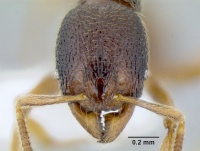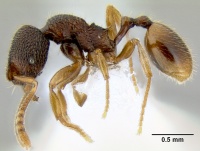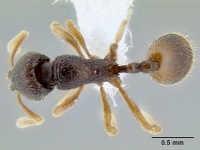Stenamma hojarasca
| Stenamma hojarasca | |
|---|---|

| |
| Scientific classification | |
| Kingdom: | Animalia |
| Phylum: | Arthropoda |
| Class: | Insecta |
| Order: | Hymenoptera |
| Family: | Formicidae |
| Subfamily: | Myrmicinae |
| Tribe: | Stenammini |
| Genus: | Stenamma |
| Species: | S. hojarasca |
| Binomial name | |
| Stenamma hojarasca Branstetter, 2013 | |
Stenamma hojarasca is a rare species known almost exclusively from sifted leaf litter collected from the forest floor. The only exception is a single specimen from a carrion baited pitfall trap in Belize. This species is found in montane mesophyll and cloud forest habitats and has been collected from 1100–1550 m elevation.
Identification
Branstetter (2013) - Integument mostly dark red-brown to orange-brown; small- to medium-sized species (see HL, ML, and PrW below); anterior clypeal margin undulating, with 4 blunt teeth; basal margin of mandible straight to slightly sinuous, without a basal notch or deep depression; gastral pilosity clearly bilayered, with a layer of suberect setae, and a layer of decumbent setae; petiole distinctly elongate (PL/HW 0.60–0.68); postpetiolar node dorsoventrally flattened and slightly elongate (PPH/ PH 0.75–0.84); eye relatively small (EL 0.07–0.11, REL 13–18), subcircular, with 4–5 ommatidia at greatest diameter; median clypeal lobe projecting dorsally outward, resulting in rather distinct dorsal and anterior surfaces (visible in profile); dorsal surface of median lobe with a pair of distinct longitudinal carinulae that strongly diverge around median lobe at anterior margin; frontal lobes slightly to very strongly expanded (FLD 0.19–0.25, FLI 31–46), either completely or mostly covering torular lobes in full-face view; propodeal spines present, short to moderate length (PSL 0.12–0.17, PSI 1.6–1.9). Similar species: Stenamma catracho, Stenamma cusuco, Stenamma ochrocnemis.
The most significant form of variation within this species is the extent to which the frontal lobes are expanded. In the Cusuco population, the frontal lobes are greatly expanded laterally and anteroposteriorly, completely covering the torular lobes in full-face view. In the other populations, the frontal lobes are only moderately expanded and they do not completely cover the torular lobes in full-face view, leaving the outer margins somewhat visible.
The form of the waist segments combined with the projecting median clypeal lobe, make S. hojarasca a very distinctive species. It should not be confused easily with any other Middle America clade species.
Keys including this Species
Distribution
Southern Mexico to Honduras.
Latitudinal Distribution Pattern
Latitudinal Range: 18.5333° to 14.9446°.
| North Temperate |
North Subtropical |
Tropical | South Subtropical |
South Temperate |
- Source: AntMaps
Distribution based on Regional Taxon Lists
Neotropical Region: Belize, Guatemala, Honduras (type locality), Mexico.
Distribution based on AntMaps
Distribution based on AntWeb specimens
Check data from AntWeb
Countries Occupied
| Number of countries occupied by this species based on AntWiki Regional Taxon Lists. In general, fewer countries occupied indicates a narrower range, while more countries indicates a more widespread species. |

|
Estimated Abundance
| Relative abundance based on number of AntMaps records per species (this species within the purple bar). Fewer records (to the left) indicates a less abundant/encountered species while more records (to the right) indicates more abundant/encountered species. |

|
Biology
Castes
Males and queens have yet to be collected.
Worker
Images from AntWeb
  
| |
| Holotype Stenamma hojarasca. Worker. Specimen code casent0622132. Photographer Michael Branstetter, uploaded by Default Group. | Owned by USNM. |
Nomenclature
The following information is derived from Barry Bolton's Online Catalogue of the Ants of the World.
- hojarasca. Stenamma hojarasca Branstetter, 2013: 120, fig. 90 (w.) HONDURAS, BELIZE, GUATEMALA, MEXICO (Chiapas).
- Type-material: holotype worker, 6 paratype workers.
- Type-locality: holotype Honduras: Cortés, Parque Nac. Cusuco, 15.48939°N, 88.23678°W±300m., 1280 m., 31.v.2010, LLAMA Wm-C-06-1-13; paratypes: 1 worker with same data but 15.48896°N, 88.23439°W±20m., 1290 m., 30.v.2010, LLAMA Wm-C-06-1-01, 1 worker with same data but 15.48683°N, 88.23442°W±300m., 1340 m., 30.v.2010, LLAMA Wm-C-06-1-02, 1 worker with same data but 15.47823°N, 88.23482°W±20m., 1330 m., 30.v.2010, LLAMA Wa-C-06-1-08, 1 worker with same data but 15.48717°N, 88.23476°W±20m., 1330 m., 30.v.2010, LLAMA Wa-C-06-1-10, 1 worker with same data but 15.48940°N, 88.23695°W±20m., 1290 m., 30.v.2010, LLAMA Wa-C-06-2-28, 1 worker with same data but 15.48839°N, 88.23592°W±60m., 1260 m., 31.v.2010, LLAMA Wm-C-06-2-02.
- Type-depositories: USNM (holotype); CASC, EAPZ, INBC, MCZC, MGBC, UCDC (paratypes).
- Distribution: Belize, Guatemala, Honduras, Mexico.
Unless otherwise noted the text for the remainder of this section is reported from the publication that includes the original description.
Description
Worker
(7 measured) HL 0.65–0.76 (0.70), HW 0.54–0.66 (0.60), FLD 0.19–0.25 (0.24), PCW 0.03 (0.03), SL 0.47–0.56 (0.49), EL 0.07–0.11 (0.11), ACL 0.46–0.56 (0.50), ML 0.81–0.99 (0.87), PrW 0.40–0.48 (0.42), PSL 0.12–0.17 (0.14), SDL 0.07–0.10 (0.08), PL 0.35–0.42 (0.36), PH 0.16–0.19 (0.17), PW 0.11–0.14 (0.13), PPL 0.18–0.20 (0.19), PPH 0.12–0.15 (0.14), PPW 0.14–0.17 (0.16), MFL 0.52–0.64 (0.55), MTL 0.42–0.54 (0.46), CI 82–88 (86), SI 82–89 (82), REL 13–18 (18), FLI 31– 46 (41), PSI 1.6–1.9 (1.9), MFI 102–109 (108), ACI1 65–70 (67), ACI2 96–102 (102).
Small- to medium-sized species; general body color dark red-brown to orange-brown, with patches of lighter brown on gaster; appendages orange-brown to yellow-brown; setae pale golden brown; mandible with 5–7 teeth, consisting of 3 distinct apical teeth, a distinct basal tooth, and 1–3 worn or denticulate inner teeth; basal margin of mandible straight to slightly sinuous, without a basal notch or deep depression; mandible mostly smooth and shiny, with scattered piligerous punctae and faint striae; median clypeal lobe projecting dorsally outward, resulting in rather distinct dorsal and anterior surfaces (visible in profile); anterior clypeal margin undulating, with 4 blunt teeth (best viewed at an anterodorsal angle); dorsal surface of median lobe with a pair of distinct longitudinal carinulae that strongly diverge around median lobe at anterior margin; remainder of clypeus mostly smooth and shiny; posterior extension of clypeus between antennal insertions narrow (PCW 0.03), with sides subparallel to hourglass-shaped; frontal lobes slightly to very strongly expanded (FLD 0.19–0.25, FLI 31–46), either completely or mostly covering torular lobes in full-face view; frontal carinae weakly developed, not extending beyond frontal lobes; head subrectangular to somewhat oval-shaped (CI 82–88), posterior margin slightly depressed medially; eye appearing small (EL 0.07–0.11, REL 13–18), subcircular, with 4–5 ommatidia at greatest diameter; head strongly rugoreticulate, with a few longitudinal costae along midline, interstices faintly punctate; scape somewhat short (SI 82–89), not reaching posterior margin of head when laid back; scape surface mostly smooth and shiny, with scattered piligerous punctae; flagellum with a somewhat distinct 4-segmented antennal club; mesosoma completely sculptured, except for propodeal declivity, which has faint transverse carinulae; promesonotal dorsum rugose to rugoreticulate and punc- tate, with rugae transverse near anterior margin, becoming arcuate, and then longitudinal posteriad; mesosomal side mostly punctate, with scattered rugulae; anterodorsal margin of promesonotum with a somewhat distinct straight to lightly curving transverse carina, anterolateral margins of pronotum forming distinct shoulders in dorsal view; anterior declivity of pronotum in profile nearly vertical, and forming a sharp transition with the dorsum; promesonotum in profile low-domed, somewhat asymmetrical; metanotal grove distinct, deeper than average; anterodorsal margin of propodeum with a distinct welt; propodeal spines present, short to moderate length (PSL 0.12–0.17, PSI 1.6–1.9); petiole distinctly elongate and gracile (PL/HW 0.60–0.68); petiolar node relatively small (PH/ PL 0.45–0.49), subconical and roughly symmetrical in profile, with a rounded dorsum; postpetiolar node dorsoventrally flattened and slightly elongate (PPH/PH 0.75–0.84); petiolar and postpetiolar nodes almost completely smooth and shining, remaining surfaces of waist segments mostly punctate, with a few rugulae surrounding postpetiolar node; gaster mostly smooth and shiny, with scattered piligerous punctae; most of body dorsum with short standing pilosity; gastral pilosity clearly bilayered, with a layer of suberect setae, and a layer of decumbent setae; scape setae decumbent to appressed; setae on legs mostly decumbent to appressed, with suberect setae on coxae and femoral venters.
Type Material
Holotype worker. HONDURAS: Cortés, Parque Nacional Cusuco, 15.48939°N, 88.23678°W ±300m, 1280m, 31 May 2010, mesophyll forest, ex sifted leaf litter (LLAMA, collection Wm-C-06-1-03) USNM, specimen CASENT0622132. Paratypes: same data as holotype but 15.48896°N, 88.23439°W ±20m, 1290m, 30 May 2010 (LLAMA, Wm-C-06-1-01) 1w, CASC, CASENT0622124; 15.48683°N, 88.23422°W ±300m, 1340m, 30 May 2010 (LLAMA, Wm-C-06-1-02) 1w, EAPZ, CASENT0622126; 15.48723°N, 88.23482°W ±20m, 1330m, 30 May 2010 (LLAMA, Wa-C-06-1-08) 1w, INBC, CASENT0621692; 15.48717°N, 88.23476°W ±20m, 1330m, 30 May 2010 (LLAMA, Wa-C-06-1-10) 1w, MCZ, CASENT0621693; 15.48940°N, 88.23695°W ±20m, 1290m, 30 May 2010 (LLAMA, Wa-C-06-2-28) 1w, UCDC, CASENT0621752; 15.48839°N, 88.23592°W ±60m, 1260m, 31 May 2010 (LLAMA, Wm-C-06-2-02) 1w, MGBPC, CASENT0622169.
Etymology
The specific epithet hojarasca is the Spanish word for leaf litter.
References
- Branstetter, M. G. 2012. Origin and diversification of the cryptic ant genus Stenamma Westwood (Hymenoptera: Formicidae), inferred from multilocus molecular data, biogeography and natural history. Systematic Entomology 37:478-496. doi:10.1111/j.1365-3113.2012.00624.x.
- Branstetter, M.G. 2013. Revision of the Middle American clade of the ant genus Stenamma Westwood (Hymenoptera, Formicidae, Myrmicinae). ZooKeys 295, 1–277. doi:10.3897/zookeys.295.4905
References based on Global Ant Biodiversity Informatics
- Branstetter M.G. 2013. Revision of the Middle American clade of the ant genus Stenamma Westwood (Hymenoptera, Formicidae, Myrmicinae). ZooKeys 295: 1277
- Dattilo W. et al. 2019. MEXICO ANTS: incidence and abundance along the Nearctic-Neotropical interface. Ecology https://doi.org/10.1002/ecy.2944
- Longino J. T. L., and M. G. Branstetter. 2018. The truncated bell: an enigmatic but pervasive elevational diversity pattern in Middle American ants. Ecography 41: 1-12.


